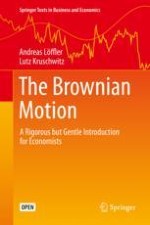6.1 Preliminary Remark: The Space of All Paths
Ideal coin | Brownian motion | |
|---|---|---|
State | Coin face | Path |
Event space | Heads or tails | All continuous functions |
\([0,\infty )\,\rightarrow \,\mathbb {R}\)
| ||
Probability |
\(\frac {1}{2}\)
| Wiener measure μ
|
